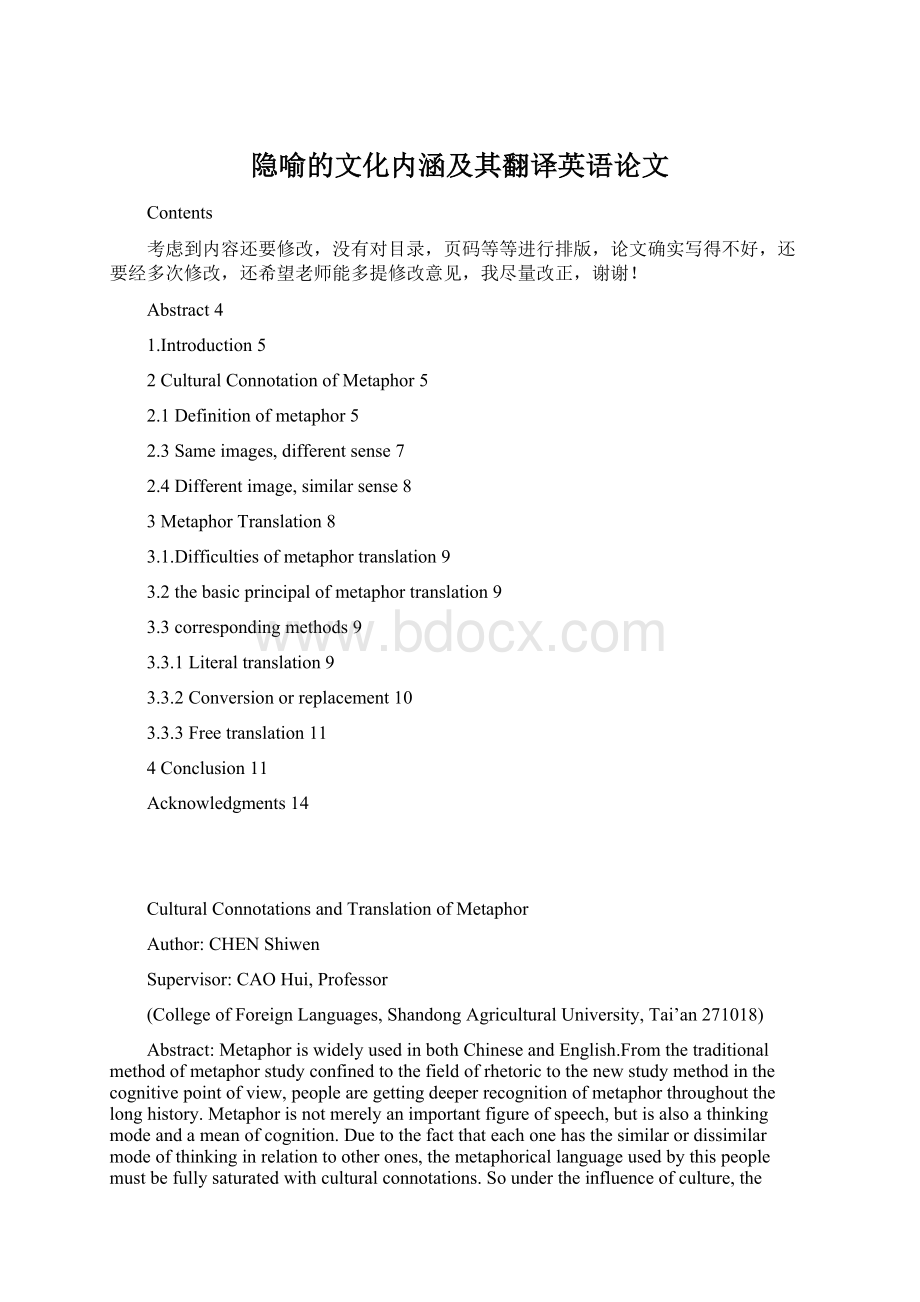隐喻的文化内涵及其翻译英语论文.docx
《隐喻的文化内涵及其翻译英语论文.docx》由会员分享,可在线阅读,更多相关《隐喻的文化内涵及其翻译英语论文.docx(11页珍藏版)》请在冰豆网上搜索。

隐喻的文化内涵及其翻译英语论文
Contents
考虑到内容还要修改,没有对目录,页码等等进行排版,论文确实写得不好,还要经多次修改,还希望老师能多提修改意见,我尽量改正,谢谢!
Abstract4
1.Introduction5
2CulturalConnotationofMetaphor5
2.1Definitionofmetaphor5
2.3Sameimages,differentsense7
2.4Differentimage,similarsense8
3MetaphorTranslation8
3.1.Difficultiesofmetaphortranslation9
3.2thebasicprincipalofmetaphortranslation9
3.3correspondingmethods9
3.3.1Literaltranslation9
3.3.2Conversionorreplacement10
3.3.3Freetranslation11
4Conclusion11
Acknowledgments14
CulturalConnotationsandTranslationofMetaphor
Author:
CHENShiwen
Supervisor:
CAOHui,Professor
(CollegeofForeignLanguages,ShandongAgriculturalUniversity,Tai’an271018)
Abstract:
MetaphoriswidelyusedinbothChineseandEnglish.Fromthetraditionalmethodofmetaphorstudyconfinedtothefieldofrhetorictothenewstudymethodinthecognitivepointofview,peoplearegettingdeeperrecognitionofmetaphorthroughoutthelonghistory.Metaphorisnotmerelyanimportantfigureofspeech,butisalsoathinkingmodeandameanofcognition.Duetothefactthateachonehasthesimilarordissimilarmodeofthinkinginrelationtootherones,themetaphoricallanguageusedbythispeoplemustbefullysaturatedwithculturalconnotations.Soundertheinfluenceofculture,thetranslationofmetaphorsbecomesthemostimportantanddifficultproblem.Thisthesisattemptstoprobeintotheconnotationsandtranslationofmetaphoronthebaseofintroducingthedefinitionofmetaphorandalsothedifficultiesandimportanceofitstranslationinhopethatitwilldosomethinggoodforthestudyontheculturalconnotationanditstranslationstrategiesofmetaphor.
KeyWords:
metaphor;culturalconnotation;translation
隐喻的文化内涵及其翻译
摘要:
隐喻在英汉语言中的应用很普遍,从传统的仅仅限于修辞学到后来的从认知角度研究隐喻,在漫长的历史中,人们对隐喻的认识正在不断加深。
隐喻不仅是一种语言现象,更是一种思维方式和认知手段。
由于英汉思维方式的有所异同,因而隐喻的使用便可以折射出中西方两种不同的文化内涵。
正因如此,隐喻的翻译就成为翻译中很复杂的问题。
本文在介绍隐喻的定义及其翻译的困难所在及重要性的基础上,深入探讨了隐喻的三方面的文化内涵,并对应的提出了相应的翻译对策,希望对关于隐喻的文化内涵及其翻译理论的研究有所帮助。
关键词:
隐喻;文化内涵;翻译
1.Introduction
Traditionalresearchersheldthatmetaphorisapurelylinguisticphenomenon,andthatitsmainfunctionistoflourishlanguages.Inthe20thcenturythatpeopleboldlybrokethroughthetraditionalideasandbegantoprobedeeperintothenatureofmetaphor.Contemporaryresearchershavefoundthatmetaphortranslationisnotonlyalinguisticactivity,butalsoacognitiveactivityofunderstandingandexperiencingonekindofthingintermsofanother.Languageactuallybecomestheimageofcultureandtranslationistheinstrumentforculturalexchange.thereisnoaspectofliferemainsyettobeuntouchedbymetaphors.Metaphorsareheavilyculture-loaded,andwecanlearnaboutculturalgeneralityandculturalpeculiaritythroughanalyzingandcomparingthecorrespondingsimilarityanddifferenceoftheimagesandsensesinmetaphorsinChineseandEnglishculture.Thus,wecananalyzeimageandsenseofEnglishmetaphorsandChineseonesfromthefollowingthreeaspectstofindouttheirculturalgeneralityandculturaldifferences.Thatis:
(1)sameimage,similarsense;
(2)sameimage,differentsense;(3)differentimage,similarsense.ThefirstofthemembodiestheculturaluniversalitybetweenChineseandEnglishwhiletheotherstheculturaldifferences.
Howtotranslatethecultural-loadedmetaphorbecometheproblem.Thisthesisattemptstoprobeintothetranslationofmetaphoraccordingtothethreeclassificationsreferredabove.Therefore,thecorrespondingmethodswillbe:
(1)literaltranslation,
(2)conversion,(3)freetranslation.Thefirstmethodispropitioustothefirstaspect,thesecondtothesecondandthethirdaspect.Freetranslation,however,canbeappliedonlywhentheothertwomethodsarequitedifficultorevenimpossibleforaprecisetranslation.Thesemethodsarestillfarlesssufficientforprecisemetaphortranslation.Itremainstoberesolvedbymoreenthusiasticresearchersinthecomingyears.
2CulturalConnotationofMetaphor
Tocomprehendmetaphorconnotation,firstlyweshouldmakeclearthedefinitionofmetaphorandthenwecananalysesitbyacertainclassification,forexample,bythecorrespondinggeneralityandculturaldifferencesbetweenimageandthesensesitrepresents.
2.1Definitionofmetaphor
Metaphor,acommonrhetoricdeviceinbothChineseandEnglishcoveringallaspectsofoursociallife,languageandculture,politicsandreligions,scienceandtechnologyisnotonlyaformoflanguageinourdailylifebutalsoabasicmodeofthinkingandbehaviorIntheWest,itwasAristotlewhofirstlydiscussedaboutwhatmetaphorreferstoalthoughhisdefinitionisquitenarrow.NowadaysEnglishdictionariesgivedifferentbutmorebroaddefinitionssuchasfollowing:
a.Awayofdescribingsomethingbycomparingittosomethingelsethathassimilarqualities,withoutusingtheword‘like’or‘as’(LongmanDictionaryOfContemporaryEnglish,2005.)
b.Thefigureofspeechinwhichanameordescriptivetermistransferredtosomeobjectdifferentfrom,butanalogousto,thattowhichitisproperlyapplicable(EnglishDictionary,SecondEdition,2002.)
InChinahowever,asearlyasWarringStatesperiod(403-221B.C.),Mo-tse,anancientChinesephilosopher,madethefirstdefinitionaboutfiguresofspeech“辟(譬)也者,举也(他)物而以明之也”.ThedefinitiongiveninCiHai(《辞海》)runs:
隐喻:
比喻的一种,本体和喻体的关系,比之明喻更为紧切。
本体和喻体之间一般要用“是”、“成为”等比喻词.
Havingcomparedthedifferentdefinitions,IwouldliketoquotePeterNewmark’swordasasummary:
"thetransferredsenseofaphysicalword,thepersonificationofanabstraction,theapplicationofawordorcollocationtowhatitdoesnotliterallydenote,i.e.,todescribeonethingintermsofanother"(NewMark,2001:
104).
Asisknowntoall,thereexistsimilaritiesanddissimilaritiesbetweendifferentculturesnomatterhowfarthedistancethatseparatestheculturalbackgroundofsourcetextandtargetaudienceintermsoftimeandplace,inotherwords,comparedtoculturesofothernations,eachnationhasitsownculturalpeculiarityaswellasitsculturaluniversality.Concerningtheproblemofhowtoanalyzeandcompareculturalgeneralityandculturalpeculiarity,wecananalyzeimagesandsenseofEnglishmetaphorsandChineseonesfromthefollowingthreeaspectstofindouttheirculturalgeneralityandculturaldifferences.HerethefirstofthefollowingrelationshipsembodiestheculturaluniversalitybetweenChineseandEnglishwhiletheotherstheculturaldifferences.Theyareasfollows:
1.Sameimage,similarsense;
2.sameimage,differentsense;
3.differentimage,similarsense.
2.2Sameimage,similarsense.
Althougheachnationhasitsuniqueculturalbackgrounds,traditionsandcustomsandmodeofthinkingetc.,manitself,alongwiththeexteriorconditionsitlivesby,suchasecologicalenvironmentsorclimateconditionhavesomethingincommon.Basedonthesamecognitiveexperience,peoplefromeverynationhaveachievedtheuniversalunderstandingofhumanitselfandtheirexternallivingsurroundings;andtheirmentalmechanismtoacceptmetaphorsisbyandlargesimilar.Forexample,头(head)hasthesameextendedsenseof领袖(leader),统治者(governor)and首长地位(leadingpositionetc.)inbothlanguages.InEnglish,headofState国家元首;theheadworkman工头;theheadwaiter服务员领班。
InChinese,头人tribalchief;头领header;头目chieftain;出人头地overtheheadsofothersetc..Let'slookatsomeexamples:
(1)papertiger纸老虎
(2)tostrikewhiletheironishot趁热打铁;(3)fatoffice肥缺;(4)one-manshow独角戏.Theseexamplesillustratethatmetaphorspartlyembodytheuniversal"core"betweenEnglishandChineseortheOccidentalandOrientalcultures,especiallyintheaspectofnaturalphenomena.Thereasonforthisisthatthenaturedoesnotkeepchanging;forinstance,thesunalwaysrisesintheeastandsetsinthewest.Andmoreimportantly,thelawandruleofthenaturalphenomenaareforeverinternal,sodifferentpeoplesoftenadoptthenaturalphenomenaasthesameimagetocreatesimilarmetaphoricalsenses,althoughtheconcretecontextsofsituationinwhichpeopleusemaybedifferent.Therefore,thereindeedaremanycompletelycorrespondenceoftheimageandthesenseinChineseandEnglish.Let'scomparethefollowingmetaphors:
(1)nominalmetaphor
A.chainreaction连锁反应
B.Shadowcabinet影子内阁
C.athunderofapplause雷鸣般的掌声
(2)verbalmetaphor
A.Toleadawolfintothehouse引狼入室
B.Toseethroughataglance一眼看穿
C.Togivesomebodygreenlight给某人开绿灯
Obviously,these‘global'imagesdonotbringaboutanymisunderstandingsbetweendifferentpeoplesdespitetheirdifferentecologicalsurroundings.Theabove-mentionedmetaphorsare,culturallyspeaking,referredtoas"culturalOverlap(文化重合现象)"(郭建中,1999:
332)orculturalgenerality.Itisjustthisculturaloverlapthatmakesthecommunicationacrosscultureseasy.
2.3Sameimages,differentsense
Withthegreatdifferenceofevolutionaryhistory,habitatenvironment,religion,thinkingmodebetweendifferentnations,differentnationsformedtheiruniqueculture.Asaresult,thesameimagemayprobablyhaveadifferentconnotationorsensesindiversecultures.Whenusingmetaphors,ChineseandEnglishpeopleoftenadoptthesameimagestosignifydifferentsenses,which,asaresult,reflectthedifferencesintheirtraditionalideas.
Colorshavedifferentassociationsindifferentlanguagesorcustoms.Forexample,blueisoftenassociatedwithdepressionorribaldryinWesternculture.InChineseculture,itrepresentssolemnnessandgrandeur,whileribaldryisrepresentedbythecolorofyellow.Greenisoftenusedinwesterncultureandisoftenassociatedwithjealousy,fresh-handorinexperiencedpeople,whileinChinese,itoftenreferrerstos